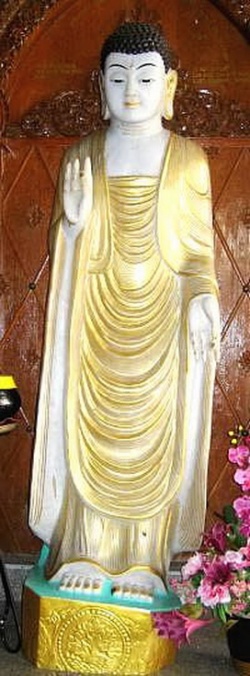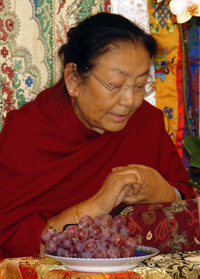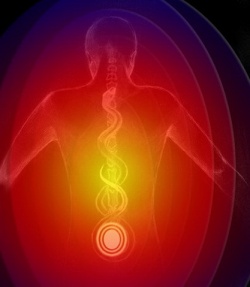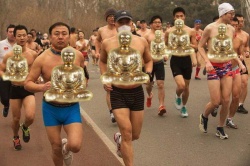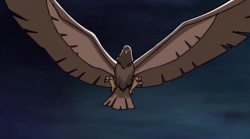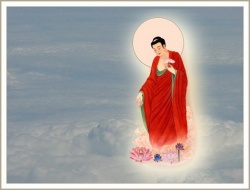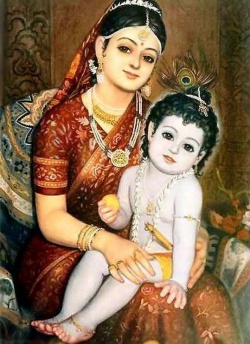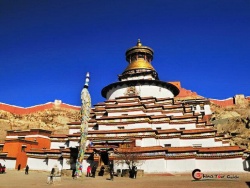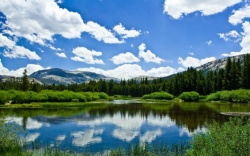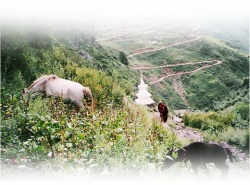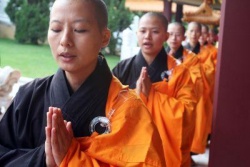Difference between revisions of "Mahavihara"
m (Text replacement - "gate" to "gate") |
|||
| Line 64: | Line 64: | ||
[[Marutta pokkharanī]], | [[Marutta pokkharanī]], | ||
| − | the northern | + | the northern gate of the [[Vijayārāma park]], |
[[Gajakumbhakapāsāna]], | [[Gajakumbhakapāsāna]], | ||
Latest revision as of 04:55, 27 January 2016
The Mahavihara (Pali for "Great Monastery") was an important Monastery for Theravada Buddhism in Sri Lanka. It was founded by king Devanampiya Tissa (247–207 BCE) in his capital Anuradhapura.
The Mahavihara was the place where the Mahavihara orthodoxy was established by Monks such as Buddhaghosa. The Monks living at the Mahavihara were referred to as Mahaviharavasins. mahavihara =large monastery
Etymology
The term Mahavihara was also applied to a number of the larger Monasteries in India, among them Nalanda, Vikramashila, Odantipura, Somapura, Ratnagiri, and others.
Theravada monastic groups
Early history
Over much of the early history of Buddhism in Sri Lanka, three subdivisions of Theravāda existed in Sri Lanka, consisting of the Monks of the MahāVihāra, Abhayagiri Vihāra, and the Jetavana Vihāra.
MahāVihāra is the first tradition to be established, while Abhayagiri Vihāra and Jetavana Vihāra is established by Monks who separated from MahāVihāra tradition.
According to A.K. Warder, the Indian Mahīśāsaka sect also established itself in Sri Lanka alongside the Theravāda, into which they were later absorbed. Northern regions of Sri Lanka also seem to have been ceded to sects from India at certain times.
According to the Mahavamsa, the Mahavihara was destroyed during sectarian conflicts with the Theravada Monks of the Abhayagiri Vihara during the 4th century. These Mahayana Monks incited King Mahasena to destruct the Mahavihara. As a result of this, a later king expelled the Mahayana Monks from Sri Lanka .
The traditional Theravadin account provided by the Mahavamsa stands in contrast to the writings of the Chinese Buddhist monk Faxian (Ch. 法顯), who journeyed to India and Sri Lanka in the early 5th century (between 399 and 414 CE). He first entered Sri Lanka around 406 CE and began Writing about his experiences in detail.
He recorded that the Mahavihara was not only intact, but housed 3000 Monks. He also provides an account of a Cremation at Mahavihara that he personally attended, of a highly respected śramaṇa who attained the Arhat stage. Faxian also recorded the concurrent existence of the Abhayagiri Vihara, and that this Monastery housed 5000 Monks.
In the 7th century CE, Xuanzang also describes the concurrent existence of both Monasteries in Sri Lanka. He refers to the Monks of the Mahavihara as the "Hīnayāna Sthaviras" (Pali: Thera), and the Monks of the Abhayagiri Vihara as the "Mahāyāna Sthaviras."
Later history
Some scholars have held that the rulers of Sri Lanka ensured that Theravāda remained traditional, and that this characteristic contrasts with Indian Buddhism. However, before the 12th century CE, more rulers of Sri Lanka gave support and patronage to the Abhayagiri Theravādins, and travelers such as Faxian saw the Abhayagiri Theravādins as the main Buddhist tradition in Sri Lanka.
The trend of Abhayagiri Vihara being the dominant Theravāda sect changed in the 12th century CE, when the MahāVihāra gained the political support of King Parakkamabāhu I (1153-1186 CE), and completely abolished the Abhayagiri and Jetavana Theravāda traditions.
The Theravāda Monks of these two traditions were then defrocked and given the choice of either returning to the laity permanently, or attempting re-ordination under the MahāVihāra tradition as "novices" (sāmaṇera).
The great Monastery at Anurādhapura, for many centuries the chief seat of Buddhism in Ceylon. It was founded by Devānampiyatissa, on the counsel of Mahinda, and included the Mahāmeghavana.
The Mahāmeghavanārāma henceforth came to be included in the MahāVihāra.
The boundary of the Vihāra was marked out by the king ploughing a circular furrow starting from near the Gangalatittha on the Kadambanadī and ending again at the river (Mhv.xv.188ff.; MT.361; Mbv. 135, 136 says that the ford on the Kadambanadī was Pāsānatittha).
A list is given in the Mahābodhivamsa (pp. 135f) of the places through which the simā (boundary) of the MahāVihāra passed -
Pāsānatittha,
Kuddavātakapāsāna,
Kumbhakāraāvāta,
the Mahānīpa tree,
Kakudhapāli,
Mahāangana tree,
Khujjamātula tree,
Marutta pokkharanī,
the northern gate of the Vijayārāma park,
Gajakumbhakapāsāna,
then passing Avattimajjha,
Bālakapāsāna on the Abhayavāpi,
Mahāsusāna,
Dīghapāsāna,
the left side of Candalagāma,
the
Nīcasusāna to the left of Kammāradeva Sīmānigrodha,
Veluvangana,
round the hermitages of the Niganthas Jotiya Giri and Kumbhanda,
to the right of the various hermitages of the Paribbājakas,
by Hiyagalla, along the shrine of the Brahmin Dīyavāsa,
through Telumapāli, Tālacatukka, to the right of the stables (assamandala),
on to Sasakapāsāna and Marumbatittha.
It then proceeded up the river to Sīhasinānatittha, on to Pāsānatittha, ending at Kuddavātakapāsāna.
The MahāVihāra contained thirty two Mālakas (Mhv.xv.214) and had numerous buildings attached to it, apart from sacred shrines, such as the Mahā Bodhi tree, Thūpārāma, Mahā Thūpa, etc. In its early period, the precincts of the MahāVihāra contained other buildings besides those dedicated to the service of Buddhism e.g., the hermitages of the Niganthas and the Paribbājakas
(as mentioned above) and the shrine of the guardian deity of Anurādhapura (Mhv.xxv.87). In the time of Vattagāmanī, the MahāVihāra Monks divided into two factions, and one party occupied Abhayagiri, built by the king (Mhv.xxxiii.97f).
At first the differences between these two factions were trivial, but, as time went on, Abhayagiri grew in Power and riches and proved a formidable rival to the older Monastery.
From time to time various kings and nobles made additions and restorations to the MahāVihāra.
Thus Vasabha (Mhv.xxxxv.88) built a row of cells, and Bhātikatissa erected a boundary wall (Mhv.xxxvi.2), while Kanitthatissa removed the boundary wall and constructed the Kukkutagiri parivena, twelve large pāsādas, a refectory, and a road leading from MahāVihāra to Dakkhinavihāra (Mhv.xxxvi.10f).
Vohārikatissa appointed a monthly gift of a thousand to the Monks of MahāVihāra (Mhv.xxxvi.32), while Sirisanghabodhi built a salāka house (Mhv.xxxvi.74). Gothābhaya erected a stone pavilion and made a padhānabhūmi to the west of the Vihāra (Mhv.xxxvi.102,106).
Towards the latter part of Gothābhaya's reign, a dispute arose between the MahāVihāra and Abhayagiri on matters of Doctrine, and sixty Monks of Abhayagiri, who had adopted the Vetulyavāda, were banished. They obtained the assistance of a Cola Monk, named Sanghatissa, and at a solemn assembly of the Monks concerned, at Thūpārāma, Sanghamitta expounded his heretical Doctrine, refuting the opposition of the MahāVihāra Monks, and succeeded in winning over the king, who was present, in spite of the efforts of his uncle, Gothābhaya Thera, to bring him round to the orthodox party. Sanghamitta became tutor to the king's sons, and when one of these, Mahāsena, became king, he prompted him to destroy the MahāVihāra.
A royal decree was issued forbidding the giving of alms to the MahāVihāra. The Monks thereupon left the Monastery, and for nine years it remained deserted. Many of the buildings were destroyed, and various possessions belonging to the MahāVihāra were removed to Abhayagiri; but the people, led by the king's minister and friend, Meghavannābhaya, revolted against the impious deeds of Mahāsena and his admirers, Sanghamitta and Sona, and the king was forced to yield.
Sanghamitta and Sona were slain by one of the queens, and the king, with the help of Meghavannābhaya, rebuilt several parivenas and restored some of the possessions, which had been removed. But Mahāsena's allegiance to the MahāVihāra teaching was not lasting; acting on the advice of a Monk named Tissa, he built the Jetavanavihāra in the grounds of the MahāVihāra, against the wish of the Monks there; the latter left again for nine months as a sign of protest against the king's attempts to remove the boundary of the Vihāra. This attempt, however, he was forced to abandon (Mhv.xxxvi.110f.; xxxvii.1 37).
Mahāsena's son, Sirimeghavanna, on coming to the throne, exerted himself to undo the damage which had been wrought by his father. He rebuilt the Lohapāsāda and restored all the demolished parivenas, together with their endowments (Cv.xxxvii.54ff). MahāVihāra had, by now, become famous as a seat of learning;
it was the centre of Theravāda Buddhism, and was the repository of various Commentaries, of which the chief were the Sīhalatthakathā on the Pāli Canon. Thither, therefore, came scholars from various countries, among them Buddhaghosa (q.,v.), who resided in the Ganthākara parivena and compiled his Pāli Commentaries (Cv.xxxvii.215ff).
When Dhātusena became king he had the walls of the MahāVihāra painted with various ornamental designs (Cv.xxxviii.43). The Dhammarucikas seem to have been favourites of this king and to have occupied the MahāVihāra, later moving to Ambatthala Vihāra (Cv.xxxviii.75). MahāNāga instituted a permanent distribution of soup to the inhabitants of the MahāVihāra (Cv.xli.99) and Jetthatissa III. planted another Bodhi tree there, called the Mahā Metta (Cv.xliv.96).
Udaya I. built a new salāka hall (Cv.xlix.14). Aggabodhi IX. discontinued the habit of the Monks of the smaller vihāras surrounding Anurādhapura from coming to MahāVihāra for their supply of medicines and made other arrangements for their distribution (Cv.xlix.88).
Sena I. and his queen Sanghā erected and endowed the Sanghasena parivena (Cv.l.70), while Kassapa IV. built the Samuddagiri parivena and gave it for the use of the Pamsukūlikas, while for the forest dwelling Monks of MahāVihāra he built forest dwellings (Cv.lii.21f.; Cv. Trs.i.163, n.8).
Kassapa's kinsman, the general Rakkha, built a Vihāra in the village of Savāraka and gave it to the incumbents of MahāVihāra, to be used as a padhānaghara, while Mahālekhasena built, in MahāVihāra itself, the Mahālekhapabbata (Cv.lii.31ff). Udaya IV. gave a diadem of jewels to The Buddha Image in MahāVihāra, while his wife Vidurā added to it a network of rays made of precious stones (Cv.liii.49ff).
During the invasions of the Colas and the Pandus from South India, and owing to the consequent confusion prevailing in The country, the MahāVihāra seems to have been neglected. Many of the buildings were destroyed and their priceless possessions plundered. Discipline among the Monks became slack and there were many dissensions.
Later, when Parakkamabāhu I. had restored peace, he wished to purify the Religion, but met with great opposition, and it was only after strenuous efforts that he brought about a reconciliation between the different parties (Cv.lxxviii.11ff).
It is said (Cv.lxxviii.25) that the king could not find one single pure member of the Order. He, therefore, held a special ordination ceremony, admitting many Monks into the Order.
After the removal of the capital from Anurādhapura to Pulatthipura, MahāVihāra lost its importance; the centre of activity was now at Pulatthipura, and later, at other capitals, and the MahāVihāra fell into neglect and decay, from which it has never recovered.
